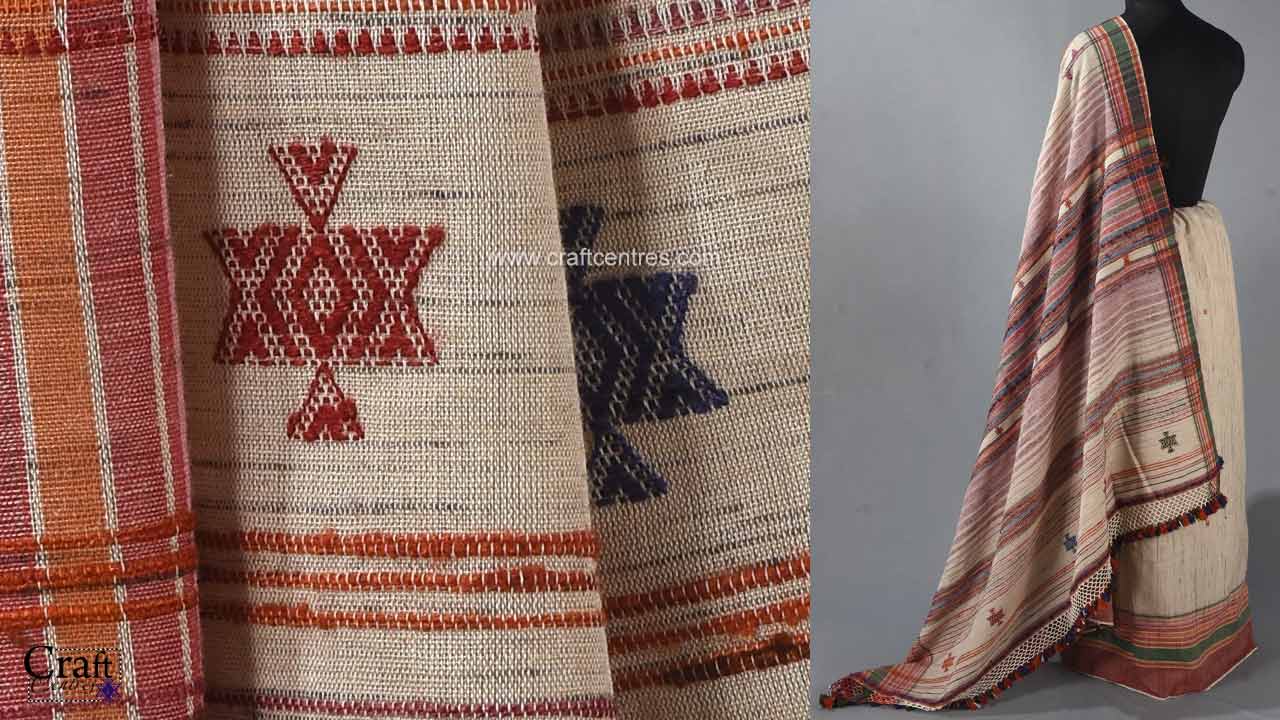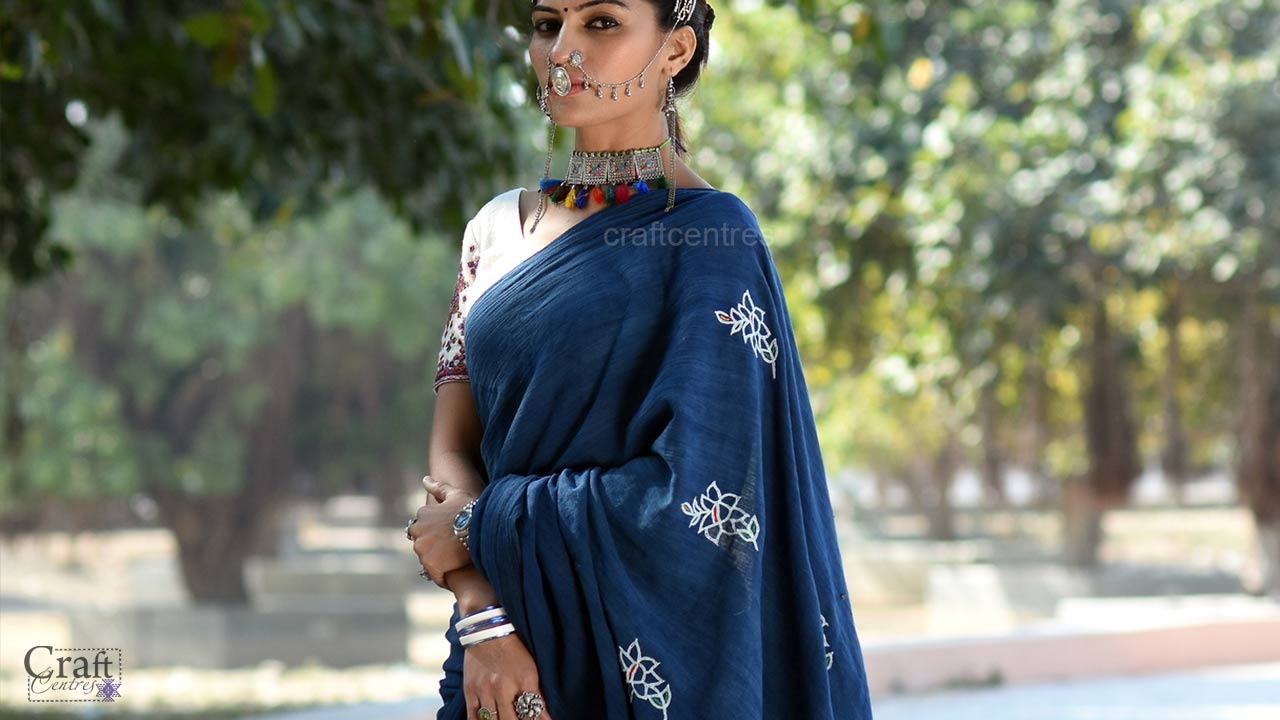Nestled in the sun-baked landscapes of Gujarat’s Kutch, the village of Bhujodi has nurtured a 500-year-old weaving tradition cherished for its simple elegance and cultural depth. Kala cotton Bhujodi saree, handwoven by the Vankar community, are more than textiles—they are heirlooms imbued with stories of community, climate, and creativity. Each saree’s earthy colours and geometric motifs echo desert horizons and generations of craft. From the nomadic Rabari past who sparked this craft to today’s conscious fashion lovers, Bhujodi sarees connect people to an age-old heritage. They meet modern tastes in sustainable style.

Origins and History of Bhujodi Saree
The legend of Bhujodi weaving begins with Rabari nomads. Centuries ago, the Rajbari’s migrated into Kutch and needed warm blankets for chilly nights. They struck a symbiotic partnership with Bhujodi’s Vankar (weaver) families: the Rajbari’s provided wool from their herds, and the weavers crafted heavy blankets (dhabla) and shawls. Over time the demand for thick woollens shifted as nomadic life changed. The Vankar adapted their skills to suit local needs. They began weaving sarees, shawls, and stoles from finer cottons and silks.
“In the past, clothing served a greater purpose than just protection; it was a primary means of identification,” reflects a Bhujodi weaver interviewed in a recent study. Indeed, each pattern in a Bhujodi weave once told the world about one’s community, age, and status. Today, Bhujodi’s geometric motifs carry forward those tribal tales and desert lore.
This craft nearly faded after the 2001 Bhuj earthquake, but revival efforts by designers and the government brought Bhujodi to global attention. Renowned brands now partner with Bhujodi artisans, and the village has become synonymous with “Kutchi weaving.” Despite modern pressures, Bhujodi remains a living tradition: pit looms still clack in village courtyards, and families teach children to weave as a birthright.
The Traditional Weaving Process
Bhujodi weaving is an intricate handloom art passed down through generations. Weavers use pit looms (floor-level looms) and an extra-weft technique. Supplementary weft threads create patterns directly in the fabric, not by printing or embroidery. This method demands extraordinary skill. A single saree can take one to two weeks or more of focused labour.
Materials: Traditional Bhujodi sarees are woven from Kala cotton, indigenous to Kutch, prized for its breathability and eco-friendly cultivation. Kala cotton thrives on rainwater. It uses 80% less irrigation than industrial cotton. Its coarse yarn gives Bhujodi cloth a textured charm. In cooler months, weavers may blend Kala cotton with wool or Tussar silk to add warmth and sheen. Natural dyes from roots, flowers and minerals colour the yarns. Think rust red from madder or deep indigo. This ensures each saree is free of synthetic chemicals.
The Weave: Bhujodi artisans follow a ritualized process. After dyeing, women spin yarn and wind it onto wooden bobbins in a precise rhythm. Men then “dance” the shuttle across the loom, interlacing weft threads row by row. The pit loom’s controlled tension yields the saree’s structured drape. Dense Kala cotton weaves produce a graceful fall weighing around 800 grams. Weavers often use antique brass bobbins and hand-built looms. One misstep or uneven tension can unravel days of work.
Motifs: Geometric symbols woven into Bhujodi cloth are laden with meaning. For example, a scorpion motif (chomak) wards off evil, triangular patterns (popati) echo the jagged Rann hills, and peacock feathers (panchiyo) signify auspicious blessings. Each design is a fragment of Kutchi storytelling. Wearing Bhujodi is like carrying the desert’s legacy on one’s shoulders.

Bhujodi textiles span more than sarees: artisans also create shawls, stoles, carpets, and scarves. In Bhujodi households, weaving isn’t just work; it’s a way of life. Children learn to thread looms almost as soon as they can toddle. They absorb pattern lore by ear and eye until their hands join the family craft. Rogan Art on Bhujodi saree is fusion of two craft is trending.
The Weavers Behind the Cloth
The creators of Bhujodi sarees are mainly the Vankar community, descendants of Meghwal weavers who migrated from Rajasthan over 500 years ago. The men of the Vankar clan traditionally handle the complex loom work, while women spin and prepare the yarn. Today, about two hundred Bhujodi weaver families keep the tradition alive.
Each saree is handwoven by skilled artisans whose. Many weavers still live in ancestral compounds, where they work side by side under the watch of the matriarch or in courtyard sheds. As one tribute from the village notes, the threads of Bhujodi are “woven with stories of resilience, nature, and cultural pride”. Recognizing this human touch is easy. Genuine Bhujodi cloth will have slight irregularities and a natural, textured feel – proof of its handmade origin.
Sustainability and social ethics are integral to Bhujodi heritage. The weavers’ reliance on organic Kala cotton and local dyes makes Bhujodi sarees environmentally gentle. Meanwhile, fair trade initiatives ensure artisans receive fair wages for their months of labour. In fact, platforms like Craftcentres.com work so that “every saree funds generational craft skills”. In Bhujodi, weaving is both livelihood and legacy. Every weaver takes pride in carrying forward this ancient craft.
Buying Guide: Choosing the Right Bhujodi Saree
For culture enthusiasts and handloom lovers, selecting an authentic Bhujodi saree is both exciting and meaningful. Here are key factors to consider:
- Material and Fabric: Bhujodi sarees come in Kala cotton, wool-cotton blends, or even silk-cotton. Kala cotton is lightweight and ideal for daily wear in warm weather. Wool-cotton blends add warmth for cooler seasons. Check labels for 100% cotton or natural fibbers – beware of polyester or nylon blends marketed as “Bhujodi.” Authentic Bhujodi will feel slightly coarse and textured, not uniformly smooth like machine-made fabric.
- Weave and Pattern: Genuine Bhujodi designs are woven in, so patterns will align seamlessly, and you may notice tiny irregularities. Common motifs include diamonds, zigzags, and tribal symbols (see motifs above). Avoid sarees that look printed or too-perfect. Real Bhujodi handloom has depth and slight warps that tell of human craft.
- Dyes and Colours: Traditional Bhujodi dyeing uses natural or low-impact dyes. Bright, even colours often indicate good-quality dyeing. If possible, ask if the colours are vegetable-based (like indigo or madder). Craftcentres sarees, for instance, proudly use zero synthetic dyes, ensuring an eco-friendly finish.
- Artisan Verification: Look for sellers who work directly with weavers. Authentic Bhujodi sellers may provide a “note from the weaver” or certificate of origin. This not only guarantees craftsmanship but also supports the community. When buying online, choose brands that explain their sourcing (e.g., Craftcentres). Beware of mass marketplaces that might sell “Bhujodi-style” fabrics made by machines.
- Price Range: Bhujodi sarees are time-intensive, so prices reflect quality handcraftsmanship. In recent markets, expect Bhujodi sarees to range roughly ₹6,000 to ₹18,000 (USD $80–$240) depending on material and complexity. Compare prices – extremely cheap sarees are a red flag for low-quality imitations. Investing in a well-crafted Bhujodi means preserving a craft and wearing a piece of art.
- Care Instructions: Bhujodi sarees are delicate. Always hand-wash, not machine wash. Use mild detergent and avoid soaking coloured threads for too long to prevent bleeding. Air dry in shade to protect natural dyes. Iron on low heat. Over time, the organic fibbers become softer. With care, a Bhujodi saree can become a cherished garment for decades.

CraftCentres.com: Your Gateway to Authentic Bhujodi Handlooms
When it comes to purchasing genuine Bhujodi sarees online, CraftCentres.com stands out as a trusted source. For over two decades (since 2001), CraftCentres has partnered directly with Bhujodi’s Vankar families. This ensures each saree is handcrafted by living traditions. In short, CraftCentres.com is praised as “your bridge to Kutch’s weavers”. They emphasize sustainability. For instance, Kala cotton uses 80% less water than industrial cotton, illustrating craft integrity. By shopping here, you wear peace of mind along with your Bhujodi. You know your fabric is climate-friendly, craft-honouring, and ethically made.
Weaving a Legacy: Heritage and Sustainability
The allure of a Bhujodi saree isn’t just its soft, earthy sheen or the way its simple patterns complement any style. It’s the knowledge that each thread was spun by hands who learned the craft as part of life. Wearing the saree is an act of cultural appreciation. In an era of fast fashion, choosing a Bhujodi handloom means choosing slow, sustainable style. Kala cotton is organic and biodegradable, and the low-impact dyes honour the earth.
When you drape a Bhujodi saree, you wrap yourself in a story. It is the story of a village that turned sand and rain into art. It is about families who keep the loom’s ancient rhythm alive and about a partnership between buyer and maker that transcends mere commerce. It’s about preserving identity. As one artisan puts it, Bhujodi sarees let you “carry the desert’s spine” through triangles and zigzags woven in fibber.
Whether you’re a fashion lover seeking unique handloom elegance, a culture enthusiast cherishing Indian craft heritage, or simply someone who values eco-friendly, artisanal clothing, Bhujodi sarees offer a tapestry of meaning. And with reliable platforms like CraftCentres.com, it’s easier than ever to buy authentic Bhujodi sarees online, directly supporting the weavers.
Embrace the timeless charm of Bhujodi. Let its patterns and pigments remind you of enduring traditions, while each wear supports a sustainable future for India’s handloom heritage.